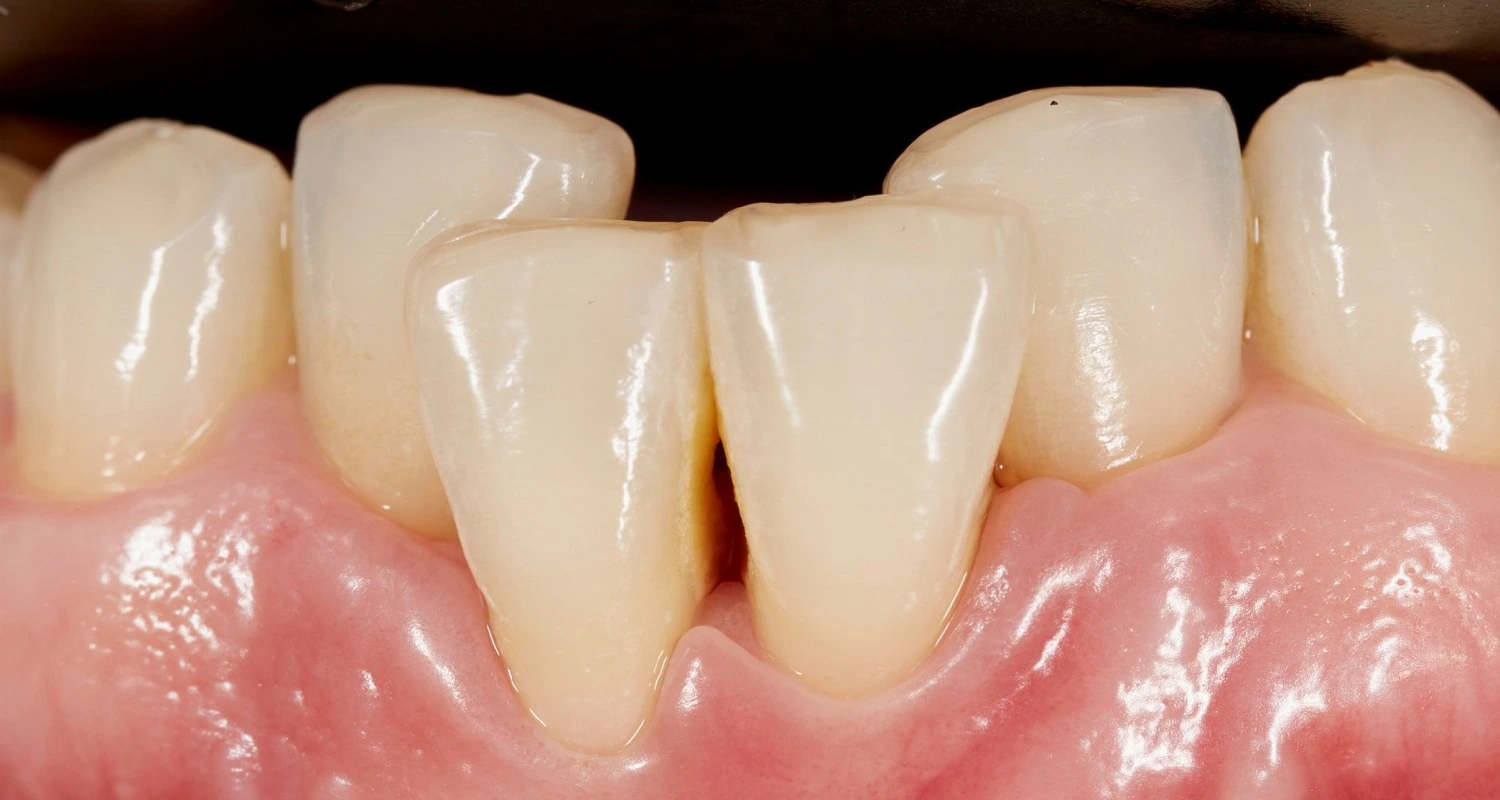✓ Fact Checked 🕓
❙ Our team of writers, editors, and medical experts rigorously evaluates each article to ensure the information is accurate and exclusively cites reputable sources.
❙ We regularly assess how the content in this article aligns with current scientific literature and expert recommendations in order to provide the most up-to-date research.
What is a Diastema?
A diastema is a space between the teeth; it occurs most frequently in the upper front set. Although it may not cause any problems, there are cases in which it can cause speech and bite malfunctions, as well as an aesthetic concern for many patients.


What are the Causes of the Gap Between the Teeth?
Gaps between teeth can be caused by:
1. Very small teeth or very large jaws
It is a matter of proportions. Size differences can be due to genetic reasons, which may involve unusually shaped teeth that are smaller than normal or jaws that grow larger than they should.
Habits: Teeth can separate as a result of:
● Using a pacifier
● Sucking a finger
● Pushing the teeth with the tongue as a constant habit or when swallowing since normally the tongue should be in contact with the palate, not with the teeth.
2. Over-inserted labial frenulum
The labial frenulum is a band of soft tissue that joins the lip to the upper gum area, just above the two upper central teeth. When this band is inserted too low and is too fibrous, it can cause a gap between the teeth, making it difficult to correct them.
3. Supernumerary teeth (Mesiodens)
Normally in humans, 32 teeth are formed, but sometimes, people have more. These supernumerary teeth are often located between the two central upper teeth; dentists refer to them as “mesiodens”. In some cases, they stay inside the bone and are not visible, making an X-ray necessary to know their existence.
What is the Treatment for Diastema?
The indicated treatment for the closure of these gaps depends upon their cause and size. There are various solutions available at the moment:
• Orthodontics: Through brackets or the use of other techniques to move the teeth, it is possible to modify their position and close some spaces, as long as the cause of the diastema has been eliminated.


• Frenectomy: When the problem is caused by a very fibrous frenulum, this can be modified with a small surgery. Then the teeth can be aligned with other methods, such as orthodontics. You can find more information about frenectomy right here.
• Dental bonding: Addresses diastema by effectively closing minor gaps between teeth. This entails the application of a tooth-colored resin to fill these spaces, ultimately resulting in a more uniform smile. This minimally invasive technique provides a swift resolution, boosting both aesthetics and self-assurance. To gain further insight into dental bonding, you can explore this article.
• Extraction of supernumerary tooth: After removing the additional tooth that created the space, the teeth can be accommodated with orthodontics.
• Functional orthopedics and therapy (correction of habits): There are devices that, when placed in the mouth, help correct the habits mentioned above. If this is done early in children, the gaps may close on their own. Often, the dentist may recommend speech therapy to change some habits.
However, given that it is not possible to correct the position of the teeth, other solutions can help hide the space:
• Veneers: sheets of dental material that overlap the teeth.
• Crowns: complete coverings to make teeth appear larger visually.
• Composite (resin) restoration: Using tooth-colored filling or dressing material, the dentist can make the teeth appear slightly wider to close the gap.
Is it Always Necessary to Correct the Spaces Between the Teeth?
The short answer is no. Most people who seek a solution to this problem do so for aesthetic reasons. However, some find a touch of originality in gaps and consider it a feature that beautifies their smile, and they are not concerned with correcting them.
While gaps may not present a major problem in some cases, having gaps between the teeth increases the risk of cavities and gum disease by allowing food debris to enter. Therefore, if you decide to keep them, you use dental floss and interdental brushes. It’s worth noting that teeth shaving can cause small gaps between teeth, which might affect your decision. Additionally, it is important to verify that there are no bite problems due to the bad position of the teeth since this could cause muscle pain and headaches.
Are Gaps in Children a Cause for Concern?


Many parents consult a dentist when they notice spaces between their children’s teeth. It is a common cause for concern since 97% of 5-year-olds usually have gaps. However, it is pertinent to clarify that in children, these spaces are necessary since the permanent teeth that begin to appear around the age of 6 are large and adult size.
They must be accommodated in the small jaws of a child, making it normal for the distance between the temporary teeth. It is also natural that while some teeth have not erupted, those emerging are separated, which in most cases will be resolved when all the teeth come out.
Gaps in children’s teeth result from natural tooth eruptions during childhood and adolescence. This process replaces primary teeth with permanent ones, often beginning with lower front teeth and progressing sequentially. Erupting teeth can cause temporary discomfort. Monitoring eruption timing is vital for assessing oral development, and regular dental check-ups ensure smooth tooth eruption and address concerns.
Can the Spaces Between the Teeth Close Naturally?
When gaps occur in children, as mentioned above, they usually close naturally, as long as there is no other factor such as an over-inserted labial frenulum or the presence of additional teeth submerged in the bone (supernumerary teeth). As all the teeth come out, they will be accommodated by taking advantage of the available space.
When this does not happen, it is advisable to visit the dentist to determine the cause of the persistence of these spaces. On occasions, when these causes are corrected in time in children, it is possible that once the origin of the diastema is removed, it closes spontaneously.
In adults, these spaces are unlikely to close on their own, so some of the available treatment options will be necessary if the patient wishes to correct this feature.
What if there is a Triangle-shaped Space Between the Teeth?


Often, patients choose treatment because, although their teeth are not separated, a small black triangle can be visible between them. These are not diastemas; rather, they are spaces caused by the loss of gum and bone that support the teeth. They are typically due to hygiene problems, which require appropriate management for periodontal disease (disease of the tooth support tissues).
How to Prevent Gaps?
Many of the causes of gaps, such as genetic dental and jaw size, are not preventable. However, gaps generated by habits such as thumb sucking, using a pacifier, or tongue thrust are preventable. Some tips help:
The use of a pacifier or the habit of sucking a thumb is not recommended to continue after the first year because the child already has several teeth in the mouth that could change position due to the presence of a strange object inside.
A good way to promote normal swallowing, without the tongue pushing the teeth, can be by promoting breastfeeding whenever possible, and when not practiced, using bottles with a shape very similar to that of the natural nipple is advised as it does not allow the exit of the liquid if there is no suction.
If the child has the habit of pushing the teeth with the tongue, it is advisable to see a dentist to correct it.
Conclusion
Diastemas can be generated by many causes and there are a variety of solutions available today. Although for many this is not a reason for discomfort, it is recommended that children see a dentist every 6 months from the time their teeth begin to appear, to identify gaps and their causes in their earliest phases, and to offer a timely and simple solution.
In the future, treatment can avoid aesthetic problems, in addition to reducing the risk of developing bite problems, cavities, and gum diseases.
Share:
References
1. Yermal, KD (Dec 13, 2022). What Is Midline Diastema. https://www.icliniq.com/articles/dental-oral-health/midline-diastema
2. Leonard, J. (Mar 4, 2020). What is a diastema? https://www.medicalnewstoday.com/articles/diastema
3. Higuera, V. (Sep 29, 2018). Diastema. Healthline. https://www.healthline.com/health/diastema
4. Abrahams, R., & Kamath, G. (Jun 29, 2017). Midline diastema and its aetiology–a review. Dental update, 41(5), 457-464. Available at: https://pubmed.ncbi.nlm.nih.gov/25073229/
5. Oquendo, A., Brea, L., & David, S. (Apr 1, 2011). Diastema: correction of excessive spaces in the esthetic zone. Dental Clinics, 55(2), 265-281. Available at: https://pubmed.ncbi.nlm.nih.gov/21473993/
6. Gkantidis, N., Kolokitha, OE, & Topouzelis, N. (Sep 23, 2008). Management of maxillary midline diastema with emphasis on etiology. Journal of Clinical Pediatric 7 Dentistry, 32(4), 265-272. Available at: https://pubmed.ncbi.nlm.nih.gov/18767455/
7. Hussain, U., Ayub, A., & Farhan, M. (2013). Etiology and treatment of midline diastema: A review of literature. Pakistan orthodontic journal, 5(1), 27-33. Available at: https://poj.org.pk/index.php/poj/article/view/76
8. Jaija, AMZ, El-Beialy, AR, & Mostafa, YA (Apr 13, 2016). Revisiting the factors underlying maxillary midline diastema. Scientifica, 2016. Available in: https://pubmed.ncbi.nlm.nih.gov/27239374/











